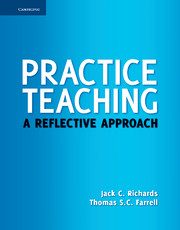Book contents
- Frontmatter
- Contents
- Introduction
- Chapter 1 Learning to Teach Through Practice Teaching
- Chapter 2 The Nature of Teacher Learning
- Chapter 3 Understanding the Teaching Context
- Chapter 4 Working With Your Cooperating Teacher
- Chapter 5 Planning Your Teaching
- Chapter 6 Teaching an Effective Language Lesson
- Chapter 7 Classroom Observation in Teaching Practice
- Chapter 8 Creating an Effective Classroom Learning Environment
- Chapter 9 Developing Learner-Centered Teaching
- Chapter 10 Classroom Discourse and Communication
- Chapter 11 Exploring Your Own Teaching
- Chapter 12 After Teaching Practice
- References
- Author Index
- Subject Index
Chapter 11 - Exploring Your Own Teaching
Published online by Cambridge University Press: 05 October 2012
- Frontmatter
- Contents
- Introduction
- Chapter 1 Learning to Teach Through Practice Teaching
- Chapter 2 The Nature of Teacher Learning
- Chapter 3 Understanding the Teaching Context
- Chapter 4 Working With Your Cooperating Teacher
- Chapter 5 Planning Your Teaching
- Chapter 6 Teaching an Effective Language Lesson
- Chapter 7 Classroom Observation in Teaching Practice
- Chapter 8 Creating an Effective Classroom Learning Environment
- Chapter 9 Developing Learner-Centered Teaching
- Chapter 10 Classroom Discourse and Communication
- Chapter 11 Exploring Your Own Teaching
- Chapter 12 After Teaching Practice
- References
- Author Index
- Subject Index
Summary
INTRODUCTION
At various times during your teaching practice you will be observed by others – by your supervisor, by your cooperating teacher, and perhaps by other student teachers. Listening to their observations of your teaching and discussing issues that arise during practice-teaching sessions will be an important part of your teaching practice experience. However, you can also collect information about your own teaching experiences and use this information to review different aspects of your teaching. Collecting information about your teaching can serve several purposes. It can provide a record of your lessons. It can provide information that you can use to assess your own performance. It can document your progress on goals that you set for yourself. It can also facilitate a deeper understanding of teaching and of your own teaching approach. In this chapter we will examine a number of ways in which this process of self-review can be carried out.
In Chapter 7 we briefly outlined various methods you can consider when collecting information about lessons you observe, such as using checklists, doing seating chart observation records (SCORE) of a lesson, writing detailed field notes and narrative summaries, and making audio and video recordings of a lesson. We will now look at these procedures more closely and describe how they can be used to assess your own lessons.
- Type
- Chapter
- Information
- Practice TeachingA Reflective Approach, pp. 150 - 160Publisher: Cambridge University PressPrint publication year: 2011

